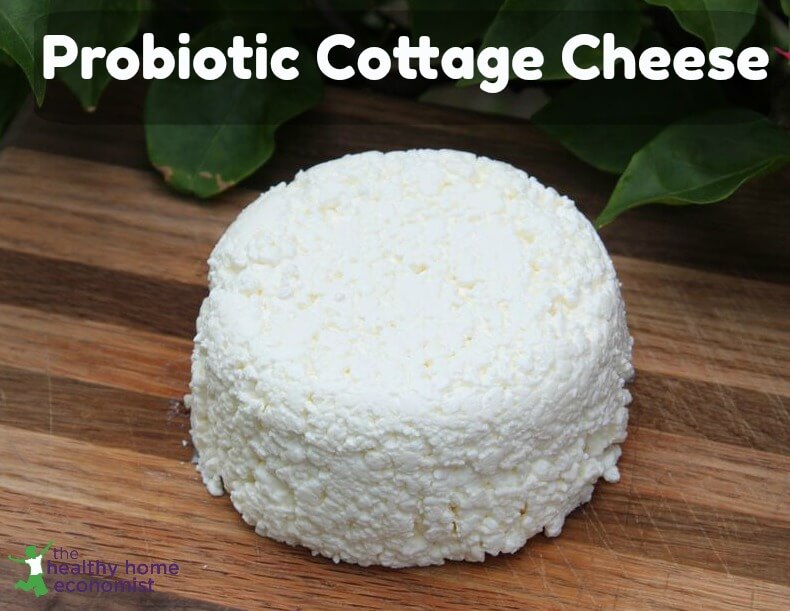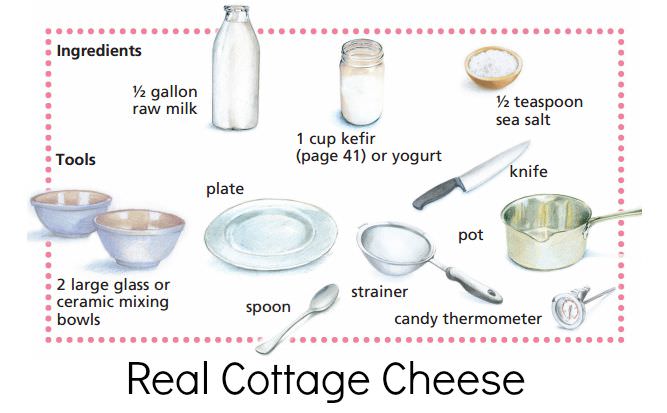Easy recipe for full fat cottage cheese with probiotics and enzymes intact which is virtually impossible to find at supermarkets or healthfood stores.

In the Western world, cottage cheese is nearly synonymous with dieting and all things related to the pursuit of skinny.
Cottage cheese is typically served with sliced fruit on top as an ultra low-calorie meal. It’s been the poster child for losing weight since the lowfat dogma of the 1960s took hold and escorted Westerners down a path to even greater weight and health challenges.
Unfortunately, the madness continues in conventional circles to this day. The American Heart Association recently blasted coconut oil as heart unhealthy. Seriously?
Why then did ancestral cultures that ate LOTS of it suffer virtually no heart disease? No wonder an increasing number of people don’t pay any attention and choose to do their own research.
While cottage cheese is certainly a nutritious, traditional food (Little Miss Muffet was probably eating something similar while sitting on her tuffet), it has, in the modern sense, seriously lost its way.
Supermarket and even organic health food store cottage cheese is highly processed and lowfat. Such concoctions are more likely to trigger binge eating than satisfy and proactively assist with sustainable weight loss goals.
This is because the skim milk from which the cottage cheese is made, organic or not, has had all the nutrient-dense cream removed. Worse, it has been pasteurized at high temperatures destroying much of the nutrition (Vitamins C and E, B12, B1, B2, folate). Digestive enzymes and beneficial microbes known as probiotics are obliterated as well.
And, as anyone who truly understands nutrition knows, skim milk and anything made with it encourages weight gain much more readily than helps you lose weight! Just ask any pastured pig farmer – skim milk is a key tool to get the pigs really fat!
Sourcing Truly Healthy Cottage Cheese
Finding probiotic and enzyme-rich, full fat cottage cheese is very difficult if not impossible depending on where you live. If you’re lucky enough to source locally, chances are it will be from a small grassfed dairy.
As a result, if you’re a cottage cheese lover like I am, it’s best to learn how to make it yourself. Fortunately, the process of making truly traditional cheese of the modern cottage variety is simple.
And, when you handcraft and consume curds and whey in this manner, it really will help you with your weight loss goals because, in a word, it will truly satisfy!
Probiotic, Enzyme Rich and Full Fat
The best recipe for full fat, raw cottage cheese (newsflash: the way it’s supposed to be) that I’ve seen is actually illustrated in The Nourishing Traditions Cookbook for Children.
That’s right, healthy cottage cheese is so simple to make a child can actually do it!
If you want to teach your children the basics of traditional cooking, this lovely little cookbook is a must-have. It’s spiral bound for easy page flipping by little hands and contains ingredient illustrations instead of hard to follow ingredient lists.
My daughter and I have been poring through it this summer to expand her culinary knowledge. I highly recommend it for anyone with children 10 and under.
Homemade Cottage Cheese
Many thanks to author Sally Fallon Morell for generously allowing the sharing of this recipe and ingredient illustration from The Nourishing Traditions Cookbook for Children.
Equipment Needed
The image below shows the equipment and ingredients you will need to get started making the homemade cottage cheese recipe.


Cottage Cheese Recipe
Easy recipe for full fat cottage cheese with probiotics and enzymes intact which is virtually impossible to find at supermarkets or healthfood stores.
Ingredients
Instructions
-
Pour the milk into a large mixing bowl (I use these glass bowls). Cover the bowl with a plate and leave it in the refrigerator until all the cream rises to the top. This might take up to 24 hours.
-
Skim off the cream with a spoon or easier still, a stainless steel turkey baster, and save it in a pint sized glass mason jar or similar container in the refrigerator (hint: you will use it later!).
-
Mix the kefir or yogurt into the milk with a spoon. Cover the bowl with a plate once more and leave on the counter at room temperature until the milk thickens like yogurt. This is what is called the curd and it will take 1-2 days depending on your home’s temperature and the freshness of the raw milk.
-
Using a knife, cut the curd in the bowl into tiny squares by slicing through it from top to bottom and left to right. Try to keep the cuts no larger than 1/4 – 1/2 inch (.64 cm – 1.3 cm) apart.
-
Fill a medium sized pot with filtered water about 1 inch deep. Put the pot on the stovetop with the burner set to low heat. Place the bowl of curds with the plate removed on top.
-
Test the temperature of the curds every 5 minutes with a digital food thermometer. After each 5 minute check, stir the curds for a few seconds. Continue with this process for about 30 minutes (6 – 5 minute checks) until the curds reach 110 F/43 C. All enzymes and probiotics will be preserved if you only heat to this low temperature. How to know? If you stick your finger in and don't get burned, no destruction of beneficial microbes or enzymes has occurred. This would happen if you heat the milk higher than 117 F/47 C, which is why it is so important to keep checking the cottage cheese every 5 minutes to ensure that the temperature doesn't get too high.
-
Remove the bowl from the heat when the desired temperature has been reached and separate the curds from the whey with a strainer set inside a mixing bowl. The curds will stay in the strainer and the liquid whey will run into the bowl underneath.
-
Rinse the curds still inside the strainer with cold, filtered water. Be sure to very gently stir the curds with a spoon until all the water drains out.
-
Put the curds in a container and mix with the sea salt and reserved cream you have in the refrigerator. You now have raw, full fat cottage cheese with all the beneficial probiotics, vitamins and enzymes from the raw milk still intact! Cottage cheese is delicious freshly made, but be sure to refrigerate any leftovers. In my experience, this truly traditional cottage cheese lasts for several weeks in the refrigerator.
Recipe Notes
Full fat yogurt may be substituted for the kefir. These yogurt brands are best.
More Information on Healthy Cheese
If learning to make cheese is exciting to you, check out my other cheesemaking posts here:









I have a gallon of sour raw milk in the fridge. Is it okay to do this with soured milk?
Thanks!
Yes, if it is slightly sour. Also, the cottage cheese will be more sour than you might like if you are going to eat it by itself. If you’re going to use it to stuff lasagna or some other purpose like that, though, it wouldn’t matter.
Thank you, Sarah! Looking forward to trying this!
This is a wonderful cookbook for children. Actually it’s a wonderful cookbook for anyone who is new to traditional foods. Less overwhelming than NT can be for someone for whom this is a total paradigm shift. I love milking my Jersey cows raised on pasture to make all these yummy goodies. We’re having ice cream for dessert tonight.
I have the same (unfortunate) dilemma as Krista of no available raw milk.
Your advise was to blend in some cream to high quality store bought
cottage cheese…then what? Do you skip the gentle heating process?
Any/what amount of time on counter?
Cottage cheese is one of my favorites! Wish I has access to raw milk,
but just not my reality…
You just stir in some cream (not ultrapasteurized if you can possibly help it) to the organic cottage cheese from the store. No heating required as the whey is already separated from the curds.
Hope you get access to raw milk soon! Nearly all 50 states permit access one way or the other now thanks to the amazing activism of the Weston Price Foundation over the past 15 years. Maybe driving across the border to a state where it is legal might work? Raw milk freezes well (and doesn’t harm enzymes or probiotics) so you can drive once a month and freeze what you won’t use in a week or two. http://www.realmilk.com/real-milk-finder/
Sarah, I put milk out on the counter in a glass jar and leave till it separates…lid on, not tight just to keep stuff from getting into it while it does whatever it is doing. Sometimes this takes 8 days..summer time takes less time to do its thing.
What is this called? I thot it was cottage cheese because it acts like it. I leave the cream on the top because it protects the milk underneath. We give the smelly cream on the top to the dogs who love it!!! because it smells too bad to want to eat it ourselves..but the dogs don’t care.
I refrigerate and we eat it sometimes with fruit, other times as a “cheese” for pasta, beans, or anything that suits our fancy. I think next time, I will add the kefir and see what it does differently.
JC, I do this in the summer with my fresh cows milk and it turns to yogurt! At least I think as it as yogurt as it catches naturally occurring bacterias and is the same consistency.
Why do we need to remove the cream and add it later? If we leave it the cheese it will be cultured too and kefir grains love cream. Did anybody tried it this way?
It doesn’t culture smoothly if you leave the cream in from the start. Also, you are not using the kefir grains … only kefir.
Nicos, I’ve tried making it without skimming off the cream first and what happens is most of the cream rises to the top during the culturing process and then ends up being drained off with the whey at the end, so it doesn’t become part of the cheese. If you want the cream to be cultured too, I suppose you could leave it in during the culturing process, but skim it off before you cut and heat the curds and then add it back in after draining off the whey. But it will make the cheese taste very sour.
I’m in British Columbia, Canada, where raw milk is ILLEGAL and considered a “health hazard by law” … if I use grass-fed, 3.5% pasteurized (not ultra) but unhomogenized milk, will this work?
It is a risk to use pasteurized milk because of the potential for foodborne illness while the mixture sits on the counter for 1-2 days. Just buy pasteurized cottage cheese from the store and blend in some cream. That would be the same thing you’d end up with at home anyway if you used pasteurized milk and somehow it did manage to culture properly.
I too can only get pasteurized milk, but I can get local grass fed un-homogenized 1/2 & 1/2 or whipping cream. Can you please provide more detailed instructions – like how much cream added to how much cottage cheese? I’ve been buying Daisy Brand, because it’s the only kind I can find that’s 4% milk fat with no weird emulsifiers.
Raw milk is unavailable here. How about organic full fat (homogenized)? Does leaving the cream in (or being unable to extract it), cause the cheese not to set? Thanks
Please see my reply to Krista as she asks the same question 🙂
I cannot get raw grassfed milk…………can I use any other milk ?
I would not recommend using anything but raw milk for this recipe.
Thank you so much for this recipe! I can’t wait to make it! And my 6-year old will be thrilled to help 🙂
Yay! Children just love to lend a helping hand, and you can really teach them some amazing stuff at a very young age.
Can you use raw goat milk even though it is naturally homogenized so there won’t be much cream rising to the top?
I have never tried making cottage cheese with goat milk. I would think it would work just fine though. Just skim off as much of the cream as you can before setting the milk to culture into the cottage cheese.